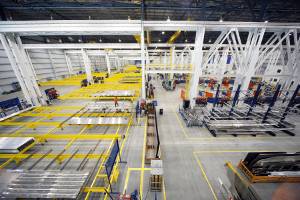U.S. Department of Defense News Release
Secretary of the Navy Donald Winter announced today the names of four new Lewis and Clark-class dry cargo/ammunition ships (T-AKE) as Matthew Perry, Charles Drew, Washington Chambers and William McLean. All of the Lewis and Clark ships are named in honor of American explorers and pioneers and are being built by General Dynamics NASSCO shipyard in San Diego, Calif.
The selection of Matthew Perry, designated T-AKE 9, honors Navy Commodore Matthew C. Perry (1794-1858), who led a squadron of ships to Japan in 1853 with the aim of opening that nation to trade. He served during the War of 1812 and the Mexican-American War, and was sent to suppress piracy and the slave trade in the West Indies.
The selection of Charles Drew, designated T-AKE 10, honors Dr. Charles R. Drew (1904-1950), a physician and medical researcher whose pioneering work in the late 1930s and early 1940s led to the discovery that blood could be separated into plasma. The model for blood and plasma storage developed by Drew has saved untold lives and is the same process used today by the Red Cross. In 1943, he became the first African-American surgeon to serve as an examiner on the American Board of Surgery. T-AKE 10 will be the first Navy ship named after Drew.
The selection of Washington Chambers, designated T-AKE 11, honors Navy Capt. Washington Irving Chambers (1856-1934), a pioneer in naval aviation. Responsible for the Navy's nascent aviation activities, Chambers arranged the world's first airplane flight from a warship. The Nov. 14, 1910, flight by aviator Eugene Ely on the light cruiser the USS Birmingham (CL-2) confirmed the potential of carrier-based naval aviation. T-AKE 11 will be the first Navy ship named after Chambers.
The selection of William McLean, designated T-AKE 12, honors William Burdette McLean (1914-1976), who conceived and developed the heat-seeking Sidewinder air-to-air missile while serving as a physicist for the Navy. During World War II, McLean worked on ordnance equipment and testing at the National Bureau of Standards in Washington, D.C. Following the war, he moved to the Naval Ordnance Test Station in China Lake, Calif., where he led the project team developing the Sidewinder missile. T-AKE 12 will be the first Navy ship named after McLean.
The T-AKEs are 689 feet in length, have an overall beam of 106 feet, a navigational draft of 30 feet and displace approximately 42,000 tons. Powered by single-shaft diesel-electric propulsion systems, the T-AKEs can reach a speed of 20 knots. As part of the Military Sealift Command's (MSC) Naval Fleet Auxiliary Force, the T-AKEs are designated United States Naval Ship (USNS). Unlike their United States Ship (USS) counterparts, the T-AKEs are crewed by 124 civil service mariners working for MSC, as well as 11 sailors who provide supply coordination. When needed, the T-AKEs can also carry a helicopter detachment.
More information on dry cargo/ammunition ships can be seen at
http://www.msc.navy.mil/factsheet/t-ake.asp. More MSC news can be seen at
http://www.navy.mil/local/MSC.

